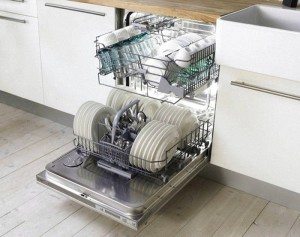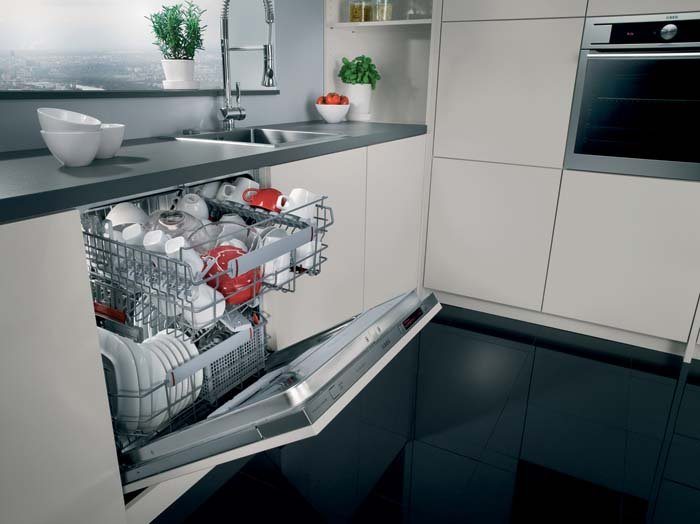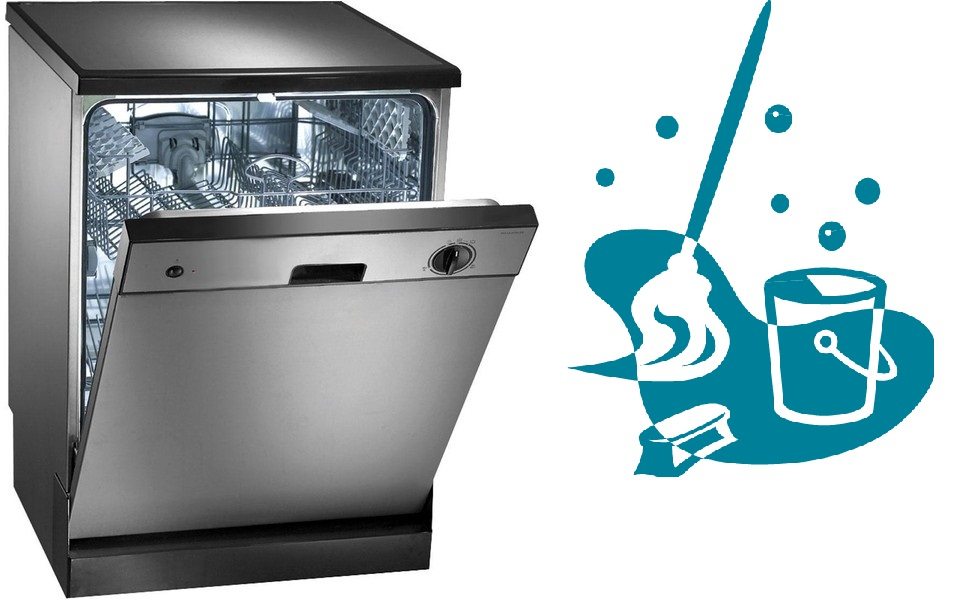How to load dishes into the dishwasher
 Proper loading of dishes into the dishwasher is one of the main conditions for quality washing. At first, loading may require at least 20 minutes of time to carefully and thoughtfully arrange everything. But over time, everything will fall into place, and you will complete this procedure in less than 10 minutes. We suggest you figure it out and watch the video on how to cope with loading dishes.
Proper loading of dishes into the dishwasher is one of the main conditions for quality washing. At first, loading may require at least 20 minutes of time to carefully and thoughtfully arrange everything. But over time, everything will fall into place, and you will complete this procedure in less than 10 minutes. We suggest you figure it out and watch the video on how to cope with loading dishes.
How to prepare dishes
Before you start putting dishes into the dishwasher compartments, you need to remove any remaining uneaten food. And the better this is done, the better the dishes will be washed and the less chance that the drain system of the machine will become clogged. You can clean the dishes with a napkin, sponge or rubber spatula; it is especially important that no fruit seeds, beans or corn remain.
Should you rinse dishes before putting them in the dishwasher? Of course, if you rinse the plates under water, they will clean better. Then a counter question arises: why do you need a dishwasher if you have to wet your hands? If you accumulate dishes, you cannot do without preliminary rinsing; dried food remains are difficult to wash off. If you are used to washing dishes immediately after eating, then you can completely put the plates in trays without rinsing.
For your information! Some dishwasher models have a pre-rinse mode, which is a big plus if dishes accumulate throughout the day.
We place glasses, cups, mugs
Now let’s take a look at different utensils one by one and how to arrange them correctly. Let's start with glasses, mugs and cups.Most dishwashers have a top tray for them. Glasses, mugs and cups should be placed upside down so that the water washes their inner surface and then flows down. A horizontal position is not permissible, since water will practically not get inside.

Wine glasses and glasses are also secured with the stem up in a special holder. The glasses should not touch each other so that the fragile glass does not break during the washing process. The plastic holder can be used not only for glasses, but also for rational placement of small tea or coffee cups.
Important! All objects must be well fixed, otherwise something may turn over under the flow of water. When you slide the top tray in, nothing should be loose.
We stack various plates
Depending on the size of the plates and their purpose, they are placed on both the upper and lower trays. On the top tray, if the volume of the dishwasher allows, you can place:
- small braids;
- bowls;
- bowls;
- saucers;
- bowls;
- gravy boats;
- salt shakers;
- dessert plates.

If necessary, and when heating the water to a low temperature, you can place plastic dishes on the top shelf, away from the heating element, so that the items do not become deformed.
Large and medium diameter plates and soup bowls are placed on the lower tray. In this case, it is better to place plates of larger diameter at the edges, and plates of smaller diameter in the center. This will ensure better access of water to the upper tray with dishes. In addition, the plates should be placed facing the center of the dishwasher so that they do not touch each other. The larger the gap between the plates, the better they are washed, so if the dishwasher allows, then place the plates less often. Overload mini dishwasher There is no point, the dishes will remain dirty, and you will be disappointed in the technique.

We stack cutlery correctly
For cutlery, which includes large and small spoons, forks and serving knives, the dishwasher has a special basket. You need to place spoons and forks freely and it is better to alternate them with each other, this will be correct. If you stack the spoons tightly together, they will not be washed. Knives should be placed with the blades down.

New dishwasher models, such as those from Bosch, have a top tray for cutlery. The placement of spoons in such a tray is horizontal. This ensures not only high-quality dishwashing, but also economical distribution of space inside the dishwasher. In addition, horizontal placement of spoons, forks and knives is safer.

Important! It is not recommended to wash sharp and ceramic knives in the dishwasher, as the blade may become dull. You cannot wash knives with wooden handles, as the wood will swell from prolonged exposure to water.
How to arrange pans and pots
As for large utensils necessary for cooking: frying pans, pots, saucepans, baking sheets, etc., they are placed in the lower container. It is best to wash such dishes separately from glassware, porcelain and crystal, choosing a more intensive mode at high temperature.
So, frying pans and baking sheets must be placed sideways, and pans upside down or at an angle. This is the only way to ensure maximum access of water to all dishes in the dishwasher. If you place the pans upside down, they will block access to the upper tray.

Important! Some frying pans and other utensils coated with Teflon are prohibited from being washed in the dishwasher by their manufacturer, so be careful.
If the handle comes off the pan, be sure to remove it. Place the pan with the handle so that it does not touch the walls of the dishwasher. When the pots are positioned as in the photo below, access to the top tray with dishes will be limited, so we do not recommend putting anything in it. In this case, you can use the “Half Load” function, which will save not only water, but also electricity. It is correct to place the baking sheets sideways along the edges of the lower tray of the dishwasher; even if there is no special attachment, the access of water from the lower spray arm will be sufficient.

Can kitchen utensils be washed in the dishwasher?
Kitchen utensils, which include cutting boards, ladles, skimmers, and spatulas, can be washed in the dishwasher only if the spatulas and boards are not wooden and preferably not plastic. Plastic spatulas can be placed in the topmost utensil tray, cutting boards in the side compartments of the lower or upper tray, depending on the size of the board. But if possible, it is better to wash the boards by hand.
Ladles and spatulas should only be placed horizontally; even if there is no special compartment for them, there is enough space for them in the upper compartment.

Tips for loading the dishwasher
When placing dishes in the dishwasher according to all the rules, the question arises of how many dishes can be washed in one cycle. The manufacturer indicates in the instructions the capacity in the number of sets. Small machines can hold up to 6 sets, narrow ones up to 11 and full-size up to 17 sets of dishes.
However, the sets may differ not in quantity, but in the size of the plates. Additionally, some may only use soup and salad bowls and no saucers. Therefore, the load on the machine may differ in different families. We suggest following a few more rules for placing dishes in the dishwasher:
- You should not load the machine with dishes to the maximum, a larger gap between items will allow for better rinsing of the products, and especially do not overload the machine;
- before putting any item in the dishwasher, make sure that it can be washed in it, especially for plastic products, fragile glass and crystal goblets;
- place objects so that they do not touch each other;
- If possible, wash pans and pots separately from plates, mugs and glasses;
- Do not wash wooden items in the dishwasher;
- If you prefer to collect all the dishes in a day, then it is better to immediately place dirty plates in the washing machine; they will not dry out in it and will be easier to wash later.
So, correctly arranging dishes in the dishwasher compartments is not so difficult. After several washing cycles, you will do this automatically. We hope our article will help you deal with this, and you can also watch this interesting video.
Interesting:
Reader comments
- Share your opinion - leave a comment
Categories
Washing machine repair


For buyers

For users

Dishwasher

















Add a comment